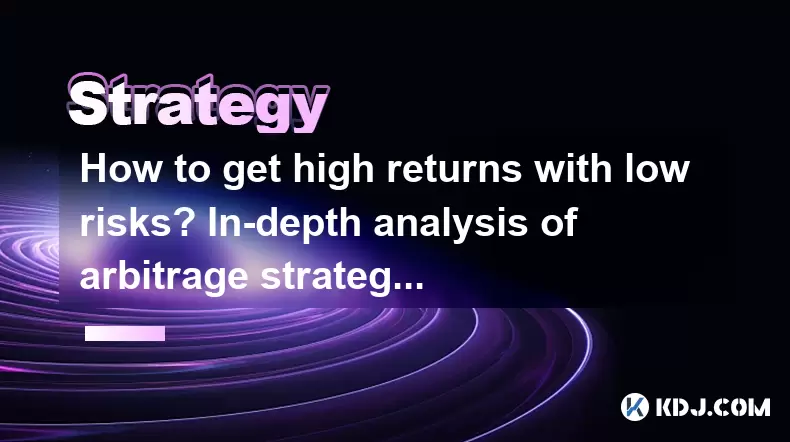-
 bitcoin
bitcoin $124586.364639 USD
0.62% -
 ethereum
ethereum $4670.671710 USD
3.33% -
 xrp
xrp $2.983701 USD
0.18% -
 tether
tether $1.000175 USD
-0.03% -
 bnb
bnb $1209.430642 USD
2.76% -
 solana
solana $231.365861 USD
0.51% -
 usd-coin
usd-coin $0.999665 USD
-0.02% -
 dogecoin
dogecoin $0.264657 USD
4.46% -
 tron
tron $0.346415 USD
1.60% -
 cardano
cardano $0.871586 USD
3.70% -
 chainlink
chainlink $23.451270 USD
7.56% -
 hyperliquid
hyperliquid $46.860071 USD
-2.96% -
 ethena-usde
ethena-usde $1.000120 USD
0.04% -
 sui
sui $3.611279 USD
1.08% -
 stellar
stellar $0.407149 USD
0.96%
How to get high returns with low risks? In-depth analysis of arbitrage strategies in the cryptocurrency circle!
Arbitrage in crypto involves exploiting price differences across exchanges for profit, using strategies like simple, triangular, and statistical arbitrage, despite associated risks.
Jun 05, 2025 at 04:14 am

Arbitrage in the cryptocurrency circle refers to the practice of taking advantage of price differences between different exchanges or markets to generate profits. This strategy is particularly appealing because it promises high returns with relatively low risks. In this article, we will explore various arbitrage strategies, their mechanics, and the risks involved, providing a comprehensive guide for those looking to delve into this potentially lucrative area of cryptocurrency trading.
Understanding Arbitrage in Cryptocurrency
Arbitrage involves buying an asset in one market and simultaneously selling it in another market at a higher price. In the context of cryptocurrencies, this typically means exploiting price discrepancies across different exchanges. The fundamental principle is to buy low and sell high, but the execution can be more complex due to the volatile nature of cryptocurrencies.
There are several types of arbitrage strategies that traders can employ, each with its own set of advantages and challenges. These include simple arbitrage, triangular arbitrage, and statistical arbitrage. Understanding these strategies is crucial for anyone looking to minimize risks while maximizing returns.
Simple Arbitrage Strategy
Simple arbitrage, also known as spatial arbitrage, is the most straightforward form of arbitrage. It involves buying a cryptocurrency on one exchange where the price is lower and selling it on another exchange where the price is higher. Here's how you can execute this strategy:
- Monitor Prices Across Exchanges: Use tools like CoinGecko or CoinMarketCap to keep track of prices across different exchanges.
- Identify Price Discrepancies: Look for significant price differences for the same cryptocurrency on different platforms.
- Execute Trades: Buy the cryptocurrency on the exchange with the lower price and sell it on the exchange with the higher price.
- Account for Transaction Fees: Ensure that the price difference is large enough to cover transaction fees on both exchanges.
This strategy is relatively low-risk because it involves minimal market exposure. However, the opportunities for simple arbitrage are often short-lived, requiring quick action and efficient execution.
Triangular Arbitrage Strategy
Triangular arbitrage involves exploiting price differences between three different cryptocurrencies on a single exchange. This strategy is more complex than simple arbitrage but can yield higher returns. Here's how to execute a triangular arbitrage:
- Choose Three Cryptocurrencies: Select three cryptocurrencies that have a triangular relationship on the exchange (e.g., BTC, ETH, and LTC).
- Calculate the Arbitrage Opportunity: Determine if there's a profitable path by converting one cryptocurrency to another and back to the original.
- Execute Trades: For example, if you start with BTC, convert it to ETH, then convert ETH to LTC, and finally convert LTC back to BTC.
- Monitor and Adjust: Keep an eye on the prices and adjust your trades to ensure profitability.
Triangular arbitrage requires a deep understanding of the relationships between different cryptocurrencies and the ability to execute trades quickly. The risk is higher than simple arbitrage, but so are the potential rewards.
Statistical Arbitrage Strategy
Statistical arbitrage involves using statistical models to identify and exploit price inefficiencies. This strategy is more advanced and typically requires a background in quantitative analysis. Here's how to approach statistical arbitrage:
- Collect Data: Gather historical price data for multiple cryptocurrencies.
- Build a Model: Use statistical techniques like mean reversion or cointegration to identify pairs or groups of cryptocurrencies that tend to move together.
- Identify Opportunities: Look for deviations from the expected relationship and trade on these deviations.
- Execute Trades: Buy the underperforming cryptocurrency and sell the overperforming one, expecting the prices to revert to their historical relationship.
Statistical arbitrage can be highly profitable but also carries significant risks, especially if the statistical models fail to predict market movements accurately.
Risks and Challenges of Arbitrage
While arbitrage strategies can offer high returns with low risks, they are not without challenges. Here are some of the key risks and challenges to be aware of:
- Market Volatility: Cryptocurrency markets are highly volatile, and price discrepancies can disappear quickly.
- Transaction Delays: Delays in executing trades can erode potential profits.
- Exchange Risks: Different exchanges have different levels of reliability and security, which can impact your ability to execute trades.
- Regulatory Risks: Changes in regulations can affect the viability of arbitrage strategies.
Understanding these risks is essential for anyone looking to engage in arbitrage trading. It's crucial to have a well-thought-out risk management strategy in place to protect your investments.
Tools and Resources for Arbitrage Trading
To successfully execute arbitrage strategies, traders need access to the right tools and resources. Here are some essential tools:
- Price Monitoring Tools: Platforms like CoinGecko and CoinMarketCap provide real-time price data across multiple exchanges.
- Trading Bots: Automated trading bots can execute trades faster than manual trading, which is crucial for arbitrage.
- Arbitrage Calculators: Tools like ArbitrageScanner can help identify arbitrage opportunities and calculate potential profits.
- APIs: Many exchanges offer APIs that allow for automated trading and data retrieval.
Using these tools can significantly enhance your ability to identify and exploit arbitrage opportunities in the cryptocurrency market.
Frequently Asked Questions
Q: Can arbitrage be done manually, or do I need automated tools?A: While arbitrage can be done manually, automated tools and bots can significantly improve efficiency and speed, which are crucial for capturing short-lived arbitrage opportunities.
Q: How much capital is needed to start arbitrage trading?A: The amount of capital needed can vary, but starting with a few thousand dollars can provide a good entry point. The key is to have enough capital to cover transaction fees and potential losses.
Q: Is arbitrage legal in the cryptocurrency market?A: Arbitrage itself is legal, but traders must be aware of the regulatory environment in their jurisdiction and ensure compliance with all applicable laws and regulations.
Q: How do I manage the risks associated with arbitrage trading?A: Effective risk management involves diversifying your arbitrage strategies, using stop-loss orders, and staying informed about market conditions and regulatory changes.
Disclaimer:info@kdj.com
The information provided is not trading advice. kdj.com does not assume any responsibility for any investments made based on the information provided in this article. Cryptocurrencies are highly volatile and it is highly recommended that you invest with caution after thorough research!
If you believe that the content used on this website infringes your copyright, please contact us immediately (info@kdj.com) and we will delete it promptly.
- BlockDAG, DOGE, HYPE Sponsorship: Crypto Trends Shaping 2025
- 2025-10-01 00:25:13
- Deutsche Börse and Circle: A StableCoin Adoption Powerhouse in Europe
- 2025-10-01 00:25:13
- BlockDAG's Presale Buzz: Is It the Crypto to Watch in October 2025?
- 2025-10-01 00:30:13
- Bitcoin, Crypto, and IQ: When Genius Meets Digital Gold?
- 2025-10-01 00:30:13
- Stablecoins, American Innovation, and Wallet Tokens: The Next Frontier
- 2025-10-01 00:35:12
- NBU, Coins, and Crypto in Ukraine: A New Yorker's Take
- 2025-10-01 00:45:14
Related knowledge

Practical parameter settings for a Bitcoin multi-timeframe moving average system
Sep 18,2025 at 10:54pm
Optimizing Timeframe Combinations for Bitcoin Trading1. Selecting appropriate timeframes is crucial when building a multi-timeframe moving average sys...

How can I filter out false breakouts in Dogecoin high-frequency trading?
Sep 22,2025 at 01:00am
Understanding False Breakouts in Dogecoin Trading1. A false breakout occurs when Dogecoin's price appears to move beyond a defined support or resistan...

Techniques for identifying tops and bottoms in the Bitcoin on-chain NVT model
Sep 20,2025 at 07:54pm
Understanding the NVT Model in Bitcoin Analysis1. The Network Value to Transactions (NVT) ratio is often described as the 'P/E ratio' of the cryptocur...

What does the surge in open interest in Bitcoincoin futures mean?
Sep 20,2025 at 11:18pm
Understanding the Surge in Dogecoin Futures Open Interest1. A surge in open interest within Dogecoin futures indicates a growing number of active cont...

How can I use the Ethereum USDT premium to gauge market sentiment?
Sep 18,2025 at 11:55pm
Understanding the Ethereum USDT Premium1. The Ethereum USDT premium refers to the price difference between USDT (Tether) traded on Ethereum-based plat...

What should I do if Ethereum staking yields decline?
Sep 20,2025 at 06:18am
Understanding the Causes Behind Declining Ethereum Staking Yields1. The Ethereum network transitioned to a proof-of-stake consensus mechanism with the...

Practical parameter settings for a Bitcoin multi-timeframe moving average system
Sep 18,2025 at 10:54pm
Optimizing Timeframe Combinations for Bitcoin Trading1. Selecting appropriate timeframes is crucial when building a multi-timeframe moving average sys...

How can I filter out false breakouts in Dogecoin high-frequency trading?
Sep 22,2025 at 01:00am
Understanding False Breakouts in Dogecoin Trading1. A false breakout occurs when Dogecoin's price appears to move beyond a defined support or resistan...

Techniques for identifying tops and bottoms in the Bitcoin on-chain NVT model
Sep 20,2025 at 07:54pm
Understanding the NVT Model in Bitcoin Analysis1. The Network Value to Transactions (NVT) ratio is often described as the 'P/E ratio' of the cryptocur...

What does the surge in open interest in Bitcoincoin futures mean?
Sep 20,2025 at 11:18pm
Understanding the Surge in Dogecoin Futures Open Interest1. A surge in open interest within Dogecoin futures indicates a growing number of active cont...

How can I use the Ethereum USDT premium to gauge market sentiment?
Sep 18,2025 at 11:55pm
Understanding the Ethereum USDT Premium1. The Ethereum USDT premium refers to the price difference between USDT (Tether) traded on Ethereum-based plat...

What should I do if Ethereum staking yields decline?
Sep 20,2025 at 06:18am
Understanding the Causes Behind Declining Ethereum Staking Yields1. The Ethereum network transitioned to a proof-of-stake consensus mechanism with the...
See all articles










































































